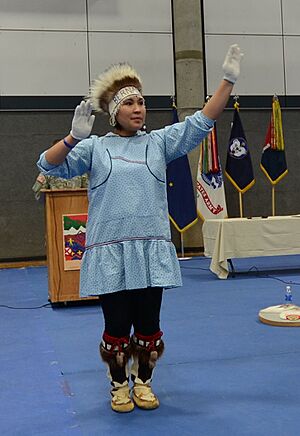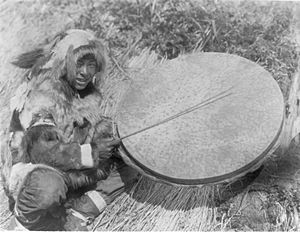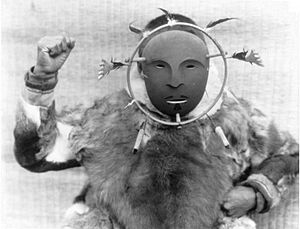Yup'ik dance facts for kids
Yup'ik dance, also known as Yuraq or Yuraqing, is a special way of dancing for the Yup'ik people in southwestern Alaska. The word yuraq means "dance" in their language. This traditional dance is usually performed to Yup'ik songs. Each dance has its own moves, made just for that song.
People who speak the Cup'ik dialect in Chevak call it Cup'ik dance. Those on Nunivak Island who speak the Cup'ig dialect call it Cup'ig dance.
Yup'ik dancing has a very specific and cultural setup. Usually, the men kneel in the front, and the women stand behind them. The drummers are at the very back of the dance group. Dance is super important to Yup'ik spiritual and social life. Long ago, traditional dancing happened in a community building called a qasgiq. Masks, called kegginaquq, were a big part of these special dances.
Sadly, Christian missionaries in the late 1800s stopped Inuit dancing. They thought it was "primitive idolatry," which means they saw it as worshiping idols. But after about 100 years, the Cama-i dance festival started in the mid-1980s. Its goal was to bring dancers from different villages together to share their music and dances. Now, many dance groups perform Inuit dances all over Alaska. Yup'ik dancing has become popular again in areas where Yup'ik is spoken.
Contents
Eskimo Dance Styles
Both Yup'ik and Iñupiaq dancing are sometimes called Eskimo dance in Alaska. There are some cool differences between the styles from northwestern Alaska (Iñupiaq style) and southwestern Alaska (Yup'ik style).
In Iñupiaq style, drummers beat the frame-drum from below, not from above. The male dancers stand up instead of kneeling. They use very few decorative dance fans, which are a must-have in the south. Also, there's still a lot of musical ceremony in Iñupiaq dance. This kind of ceremony didn't develop as much in the south and southwest of Alaska, even though it did exist there.
The Ways of Yup'ik Dancing
Yuraryaraq means "ways of dancing" in Yup'ik. It includes six main parts that are key to Yup'ik dance:
- Ciuliat (ancestors)
- Angalkuut (shamans)
- Cauyaq (drum)
- Yuaruciyaraq (song structures)
- Yurarcuutet (regalia or special clothing)
- Yurarvik (dance location)
Honoring Ancestors
The ancestors, called ciuliat, are highly respected. Yup'ik people believe their ancestors are still a part of their lives.
The Role of Shamans
Shamans, called angalkut, played a very important role in dance. They were like leaders who connected the human world with the spirit world. They used music, dance, and masks to do this. Shamans would perform old prayers to ask for what the people needed to survive.
Shamans often carved special masks for many Yup'ik ceremonial dances. These masks showed spirits that the shaman saw in their visions. Some masks, called Nepcetat, were thought to be very powerful. Shamans would wear masks of animals like seals, moose, wolves, eagles, and fish, along with drums and music.
The Important Drum
The drum, called cauyaq, is the only instrument used in Yup'ik dancing. It's played with a drum stick. The drum has a round, bentwood frame with a special handle. Long ago, the drumskin was made from the stomach lining of a mammal.
The drum was treated with great respect and used for special ceremonies. The Yup'ik calendar even has a month, November, named Cauyarvik or Causarvik, which means "place for drumming." This shows how important drumming is!
How Songs Are Built
The way songs are put together, called yuaruciyaraq, is very specific for ceremonies. Music must follow certain rules, just as Yup'ik ancestors practiced. These musical forms include a warm-up chorus, a main chorus, a first verse, a silent motion part, a second verse, and an encore.
Special Dance Clothing
The special clothing and items for dancing are called yurarcuutet. These include:
- Qaliq: A fancy fur parka.
- Nasqurrun: A headdress made with wolf, wolverine, or caribou fur and beads.
- Uyamik: Beaded necklaces.
- Tegumiak: Finger masks or woven grass dance fans.
- Piluguuk: Decorated boots.
- Ivory or beaded earrings.
Men often use round wooden fans with waterfowl or owl feathers. Today, both male and female dancers wear a special hand-sewn pullover called a qaspeq.
Dance masks, called kegginaquq, were a very important part of Yup'ik ceremonial dancing. Hand-held fans make the dancer's arm movements look even more graceful. They were used in old winter ceremonies and are still part of today's Yup'ik dance outfits. Men's fans have feathers put into wooden hoops.
Women also wore special headdresses, and these are still used by both men and women in modern Yup'ik dance.
Where Dancing Happens
The dance location, called yurarvik, means "place for dancing." In ancient times, people danced in the qasgiq. The qasgiq was the community center for ceremonies and festivals. These events included singing, dancing, and storytelling.
Different Kinds of Dances
Yuraq is the general term for a regular Yup'ik or Cup'ik dance. These dances often show animal behavior, hunting, or playfully tease people.
But for inherited dances, they use the term Yurapik or Yurapiaq, which means "real dance." A yurapik is a long story dance performed by women. It can also be a dance style with no song, passed down through families.
Some other types of dances include:
- Nangercelluku: First dances.
- Yagirat: Motion dances.
- Cukaqautet: Fast beat dances.
- Ciuqitet: Contemporary (modern) dances.
- Ingulautet: Slow dances.
Rhythmic dances combine special gestures, storytelling, songs, and the use of drums and masks. There were six main styles of yuraq:
- Arula dances: These had a yuraq, a verse, and a chorus.
- Yurapiat: Storytelling dances.
- Ingula dances: Slow, old-style dances performed by women after berry harvests.
- Pualla dances: Mostly performed by men.
- Yurat done to taitnauq songs.
- Telciqata'arcutet: Proper entrance dances.
Why Dancing Was Stopped
Traditional native dances were stopped because of big changes in the late 1800s. These changes came from the fur trade, diseases, and Christian missionaries. When Europeans and Americans came to Alaska, they brought hardships for the native people. There were epidemics, strong Christian missionary activities, and new education rules, like only speaking English.
Ancestral Eskimo dancing and non-Christian festivities, traditional ceremonies, and shamanistic rites were discouraged. Missionaries even called them "primitive idolatry" and banned them. They thought these dances were "heathen idol worship, devil's frolic, and black art."
The Moravian Church banned dancing from villages. The Russian Orthodox priests stopped yuraq dancing feasts between villages in the King Salmon and Naknek areas by 1933. Jesuit missionaries also forbade dancing as part of Yup'ik feasts by the end of the 19th century. Many spiritual ceremonies, like the Agayuyaraq (a masked dance ceremony at the end of winter), were stopped. Masked dances were among the first to be removed from Yup'ik practice.
Dance Festivals Bring Back Tradition
Today, many dance groups perform Eskimo dances in Alaska. There are many performances and festivals that keep the traditional ways alive. Masked dances, especially, remind people of the strong connection to animals and spirits. Dances show how the Yup'ik people see the world and how they live their lives.
Today, a dance festival is a huge event for an entire village, just like it was long ago. Both getting ready for the festival and the actual event are very important.
The first Yup'ik dance festival was Yupiit Yuraryarait, which means "Yup'ik ways of dancing." It started in 1982 in St. Mary's. This festival helped bring back Yup'ik traditions. People in St. Mary's were worried about their culture disappearing. So, they brought together artists from villages where traditional dancing was still practiced. The goal was to pass on dance traditions to younger generations. Nine villages from the Yukon–Kuskokwim Delta came to that first festival. Its success led to more dance festivals all over the lower Yukon River region. The Yupiit Yuraryarait festival is now held every three or four years.
The second Yup'ik dance festival is Cama-i, which means "hello" or "good to see you again." It started in 1984 in Bethel. Traditional dancers from all over Alaska and even other places come to the Cama-i dance festival every March. Bethel is special because it has many different cultures, including a large group of Koreans. The Cama-i dance festival is an annual event in Bethel. It hosts Alaska Native dancers from all over the state, as well as dancers from Korean and Japanese groups, and other parts of the world.





